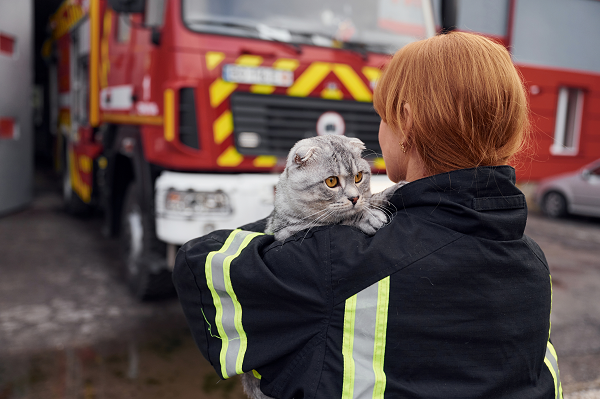
In honor of Pet Fire Safety Day, on July 15, take some time to ensure that you have a fire safety plan in place that includes your pets. Make your home fire safe for your pets, and include your pets in your evacuation plan.
Preventing Pet-Related Fires
- Unattended candles are a no-no, especially around pets. Cats and dogs can topple a burning candle easily, igniting surrounding objects, and large dogs can knock over a candle with a quick wag of their tail. Keep open flames out of reach and never leave a burning candle unattended. You may want to consider flameless, battery-run candles. They look like real candles and are much safer.
- Place flammable liquids and cleaners in cabinets away from curious pets. In addition to being fire hazards, these compounds are usually toxic if ingested.
- In cold months, monitor access to fireplaces. While most pets won’t approach a hot fire, some curious pets may burn their nose on the protective glass while checking out the flickering flames. They may also nudge flammable toys or other items too close to a hot fire, which could ignite before you realize they are there.
- Keep electrical cords out of reach of your pets. Pets that chew on cords can suffer electrical burns to their mouths and die from electrocution. In addition, nibbling pets such as rabbits can remove the protective insulation from wires, resulting in sparks that could start a fire.
- Make the stove safe. Cats have been known to jump onto a stove and inadvertently turn a stove knob and leaping dogs can also accidentally turn a knob, igniting items left on the stove top. Be sure to use knob covers or remove knobs entirely, and never leave items on the stove.
- Make sure all your smoke detectors are in working order. There should be at least one smoke detector on each floor of the house.
Pet Evacuation Plan
Include your pet in your family’s evacuation plan.
- Make sure everyone in the house knows how to get out of the house in an emergency and where to meet once out.
- Keep a leash close to your dog’s bed or crate to help you guide your dog out of the house.
- Establish who will be responsible for each pet, but never risk your own life to rescue your pet and never go back inside your home to retrieve pets. In the event of a fire, it is important to get out and stay out. Call the fire department as soon as you are outside.
- Place decals on windows and doors to identify the type and number of pets that are located inside. This lets fire fighters know that there are pets to be rescued inside your home.
- Make sure your pet is identified with a microchip and/or ID tags or ID collar. Your pet may escape in the chaos of a fire and having your pet easily identified is key to your pet’s safe return.
After a Fire
Even if your pets seem fine, take them to your veterinarian for an assessment as they may have inhaled smoke. If your pet is having difficulty breathing, ask emergency workers to provide oxygen. Some rescue vehicles are equipped with oxygen masks specially made for dogs and cats.
Once the fire is out, managing the aftermath is much easier if you have a disaster kit prepared. In addition to important household documents, include your pet’s medical records, proof of vaccination, medication record, and your veterinarian contact information. This will help in case you can’t take your pet with you to a shelter or hotel and need to board them instead.
Losing your home to a fire is devastating, but losing your pet makes a sad situation even more difficult. Taking a few precautions and being prepared can protect your entire family from a fire in your home.